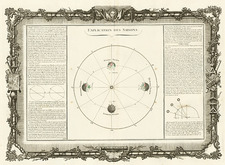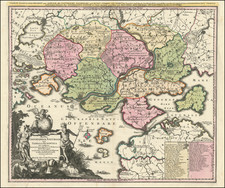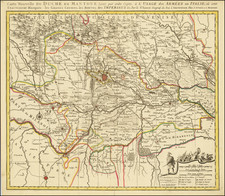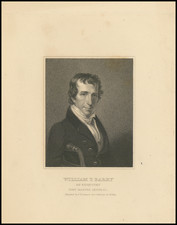With Abraham Ortelius in the Foreground!
Two views from east and west of Lake Agnano and the extinct city of Cumae, Italy by Braun and Hogenberg. These views are engraved after drawings by Georg Hoefnagel.
The Grotto of the Cumaenan Sibyl
The verso translates as follows:
On the way to Lake Averno from Cumae, an exceedingly famous and ancient city in Campania, is the Sibyl's grotto. This cave is carved into the rock in a wondrous and unique fashion. It is generally believed that this is where the Sibyl of Cumaea lived.
This is a view of Lake Averno from the east, with the entrance to the Sibyl's grotto and the temple of Apollo. In the middle we see Hoefnagel and Ortelius engaged in conversation. The inscription at their feet reveals they are discussing both the etymology of the place name and its ancient context; they are making an empirical examination of the classical texts: The Greek name means "birdless", it could be taken to be the entrance to Hades. Yet Hoefnagel points demonstratively to the five ducks in the middle of the lake, thus refuting claims that Lake Averno was the entrance to the Underworld in this day (information by Stephan Pelgen). Earlier commentators have suggested that Hoefnagel and Ortelius are pointing to the temple of Apollo, thus failing to appreciate the inherent humor of the illustration and its inscriptions.
Lake Agnano
The verso text translates as follows
Lake Agnano is not far from the city of Pozzuoli, with a broad shore all around it. Near Pozzuoli there are blow holes, others call them the caves of Charon, which emit a deadly vapour. There is a cave deep in the rock, with a sign next to it warning people not to approach it too closely.
The second view, which is as ornately framed as the first, shows the volcanic Lake Agnano with the Grotta del Cane (Dog's Cave), so called because gases rise constantly from its floor up to a height of about 45 cm, so that a dog, upon entering it, immediately becomes unconscious. The lake was probably first formed in the Middle Ages, since it is not mentioned by the authors of classical antiquity; it was drained in 1870. To the right of the lake are the Stufe di San Germano, chambers in which the hot sulphur gases are stored for medicinal purposes. As in the plate of Pozzuoli and Baia, the instructive inscriptions make reference to the discussion between artist and scholar.
Georg Braun (1541-1622) was born and died in Cologne. His primary vocation was as Catholic cleric; he spent thirty-seven years as canon and dean at the church St. Maria ad Gradus, in Cologne. Braun was the chief editor of the Civitates orbis terrarum, the greatest book of town views ever published. His job entailed hiring artists, acquiring source material for the maps and views, and writing the text. In this role, he was assisted by Abraham Ortelius. Braun lived into his 80s, and he was the only member of the original team to witness the publication of the sixth volume in 1617.
Frans Hogenberg (ca. 1540-ca. 1590) was a Flemish and German engraver and mapmaker who also painted. He was born in Mechelen, south of Antwerp, the son of wood engraver and etcher Nicolas Hogenberg. Together with his father, brother (Remigius), uncle, and cousins, Frans was one member of a prominent artistic family in the Netherlands.
During the 1550s, Frans worked in Antwerp with the famous mapmaker Abraham Ortelius. There, he engraved the maps for Ortelius’ groundbreaking first atlas, published in Antwerp in 1570, along with Johannes van Deotecum and Ambrosius and Ferdinand Arsenius. It is suspected he engraved the title page as well. Later, Ortelius supported Hogenberg with information for a different project, the Civitates orbis terrarium (edited by Georg Braun, engraved by Hogenberg, published in six volumes, Cologne, 1572-1617). Hogenberg engraved the majority of the work’s 546 prospects and views.
It is possible that Frans spent some time in England while fleeing from religious persecution, but he was living and working in Cologne by 1580. That is the city where he died around 1590. In addition to his maps, he is known for his historical allegories and portraits. His brother, Remigius, also went on to some fame as an engraver, and he died around the same time as his brother.









![[Jonah Negotiating His Embarkation] Quid demens latebras circumspicis alterum in orbem. Si fugirs Dominum, non tamen effugies. Cui tellus paret, summus cui militat aether, Non parere putas huic etiam Oceanum](https://storage.googleapis.com/raremaps/img/small/85070.jpg)

![Сны Султана (Картина 2) [Dreams of the Sultan. Scene 2]](https://storage.googleapis.com/raremaps/img/small/60238.jpg)


